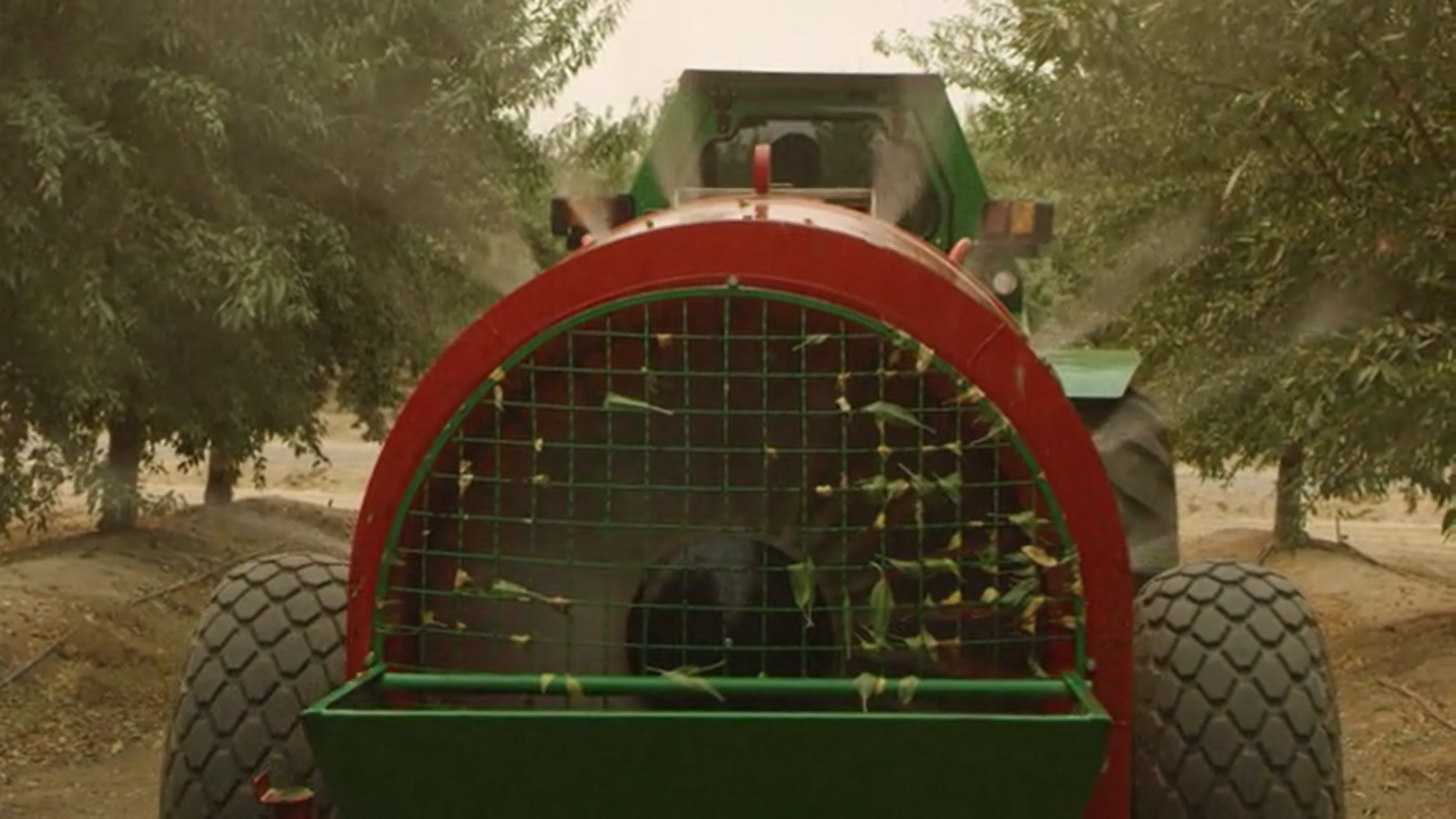Essential considerations for fruit growers, nut farmers and vineyard owners
Pesticide drift is a concern for every orchard, grove, nursery and vineyard owner. Not only does it create waste, but it can also pose a hazard to farm workers, adjacent non-targeted crops, neighboring farms, wildlife, waterways, and the environment in general. Moreover, because pesticide drift is regulated by both federal and state laws, it can result in regulatory fines and legal issues.
The EPA defines pesticide drift as the unintentional airborne movement of pesticide dust (or droplets) during or soon after application, to any site other than the intended spray area. Pesticide droplets are produced by spray nozzles or air streams used in application equipment for spraying pesticides on crops, forests, turf and home gardens.
Drift vs. Overspray
Drift is especially problematic for operators whose farms are near residential areas, schools, hospitals and assisted living areas. Drift should not be confused with overspray. Overspray is the application of chemicals beyond the targeted site as a result of operator error. Regardless of the type of spraying system used, some amount of drift is unavoidable.
According to Growing Produce, the EPA estimates that 500 million pounds of pesticides are applied annually in the United States. Post application, three percent of that total will drift in spray, vapor or particle form onto unintended targets. Spray drift is the most common of the three.
Three factors that contribute to drift
Understanding the factors that contribute to pesticide drift is key to controlling it. Let’s consider the environmental factors, physical properties of sprays and application methods that impact drift:
1. Environmental factors
Wind speed and direction. Wind is the greatest environmental contributor to pesticide drift. Drift potential is lowest at a maximum wind speed of seven miles per hour. Care should also be taken to avoid spraying at times when the wind direction will carry drift directly towards sensitive or highly populated areas.
Air temperature and humidity. When spray pesticides are applied at times of high air temperature and low humidity, they can evaporate completely before landing on their intended target. In these conditions, the herbicide takes on particulate form and becomes biologically inactive unless it comes back into contact with water. Ideally, operators should spray in temperatures under 80℉, with humidity in the 45-50% range.
2. Spray properties
Droplet size. Small nozzle tips combined with high pressure produces smaller droplets, which have a higher propensity to drift than larger ones. Droplets of less than 150 microns (µm) can travel as far as several miles from the application site before dissipating. Conversely, droplets that are too large may hit the intended target, but then roll off before the leaf can absorb the pesticide.
Volatility. Low-volatility sprays are much less likely to vaporize during and immediately after application than higher volatility sprays. Pesticides that have volatilized into gaseous form can drift farther for a much longer period of time than liquid. For example, under the right conditions, 2,4-D can drift and settle on an unintended target more than one-half mile away. Operators should not apply high volatility sprays at times when the temperature is expected to rise significantly. Refer to the product labels for warnings about the potential for vapor drift.
Surfactants. Surfactants break surface tension on leaf surfaces so that pesticides can spread more evenly and adhere longer (particularly on waxy-leafed plants.) They are found in alcohol, silicate or other organic forms. While some surfactants may improve spray adherence, care should be taken with use, as the properties of the surfactants may damage the leaves themselves.
Solubility. Pesticides with poor solubility can result in uneven spray distribution, which leads to drift. Operators should also regularly check their equipment for good agitation. EC formulations and flowables are the best choice for overall solubility and even spray.
3. Equipment and application methods
Calibration issues. Sprayers that are not properly calibrated are a large contributor to drift issues. These problems include:
Excess output: Contrary to widely held beliefs, only 15% of a plant’s leaf needs to be covered to protect the plant. Excess water/product mix application will result in too-large droplet size, over-saturation and run-off.
Excess pressure: If the sprayer pressure is set too high or the equipment’s pressure gauge is faulty, smaller, drift-prone droplets will result.
Excess velocity: Air-assisted sprayers with fans set too high also create smaller, drift-prone droplets.
Timing. As mentioned above, weather and wind conditions are large contributors to drift.Operators should take advantage of advanced weather forecasting techniques and plan their spraying accordingly, as weather conditions can shift dramatically over the course of a few hours.
Application speed. Operators should maintain the recommended speed for their nozzles to ensure that the application speed does not exceed the pressure limits of the nozzles. Increased operating speeds can also create upward wind currents behind the sprayer and trap small droplets, causing them to drift. The ideal application speed is between two and five m.p.h., depending on the canopy density.
Nozzle size. It’s essential to use the specified nozzle size for any sprayer. Nozzles that are too small to create the desired output per nozzle will produce droplets that are too small.
Sprayer maintenance and nozzle replacement. Proper cleaning and regular maintenance, calibration and replacement of the sprayer and nozzles will also help reduce drift, regardless of the type of sprayer used. Sprayers should be calibrated at least twice per season and cleaned both inside and out after each application. Worn or clogged nozzles can produce poor droplet distribution and spray patterns that are not aligned with the sprayer’s calculated calibration.
Density-based spray systems are the best option for reducing drift. Precision agriculture and farming technology advances have brought about new application methods that allow operators to reduce chemical use, cost and waste while simultaneously reducing pesticide drift.
Density-based precision spraying systems (“smart” sprayers) can significantly reduce pesticide drift because they not only sense the presence of trees and plants, but also the density and shape of the tree canopy or plant itself. The Smart ApplyⓇ Intelligent Spray Control System™ operates on LiDAR sensors, which scan 120,000 points per second. As the LiDAR measures the crop density, it controls each of the solenoid nozzles, while a GPS unit determines location and ground speed. As a result, density-based spraying systems are able to deliver the precise amount of chemicals needed to protect the targeted trees and plants, minimizing over-saturation, run-off, drift and groundwater contamination. In fact, recent studies have shown up to an 87% reduction in airborne drift.
Reducing pesticide drift is a high priority for operators in every growing industry. Considering environmental factors, the properties of chemicals used in spraying, and equipment and application methods combined with farming technology advances can all contribute to reduced drift and the risks associated with it.
Based in Indianapolis, Indiana, Smart Apply, Inc. manufactures the Smart ApplyⓇ Intelligent Spray Control System™, the only density-based, intelligent spray system available on the market today. At Smart Apply, we’re committed to helping tree and nut growers and nursery owners across the United States and around the world realize chemical cost savings, improved sustainability through healthier trees and plants, cleaner and safer groundwater and greater overall yields, with an easy-to-use, reliable system based on years of research and cutting-edge technology.
Advanced Crop Reporting
In 2020, Smart Apply announced the enhanced capabilities of crop reporting, heat mapping, targeted spraying and John Deere Operations Center interface to the Smart Apply Intelligent Spray Control System.
Learn more about the Smart Apply Intelligent Sprayer:
Visit smartapply.com to get more information and request a demo.
Call: 317.222.4152 to talk to a Smart Apply expert today.
If you’d like to partner with a company that’s revolutionizing agriculture spraying systems and get ahead of the curve, join the Smart Apply team today.

